It’s a familiar story in our sector: budget is found for one person from a busy NGO team to attend an external training course. She finds the course uplifting but when she returns to her team, it’s business as usual. She tries to give a report back in a team meeting, but it’s hard to convey all the learning from a 5-day training course in ten minutes. At a planning meeting, she then tries to suggest that the team applies the tools and approaches from the training course. But the other team members don’t properly understand these tools and the team’s manager is away on a field trip. So things drift on as before and six months later everyone has forgotten about the training course, including the person herself!

This was just the kind of scenario which ADRA (the international development organisation of the Seventh Day Adventist (SDA) Church) wanted to avoid when they contracted me to support the development of their country programmes’ new advocacy strategies in early 2019.
While ADRA is new to advocacy, people nearly always have experience of its essentials: influencing powerful stakeholders to do something. To enhance these skills and embed them widely, ADRA wanted to make sure that all of the ten country teams piloting their global advocacy campaign (`Every Child – Everywhere – In School’) benefited from INTRAC’s inputs – and not just the individuals attending the training course in South Africa in June 2019. So people were asked to complete a series of ‘homework’ exercises several months before the training course, contained in a homework handbook. This made it possible to involve ADRA’s whole country teams in the early stages of developing the national strategies and to build team capacity in advocacy at the same time.
Beyond the country teams, ADRA also knew that the successful delivery of the advocacy strategies would depend on buy-in from SDA church leaders. Two representatives therefore attended the training course from each of the ten countries – one from the ADRA country office and the other from the Adventist church, which was somewhat challenging for the trainer as the church representatives had less understanding of either advocacy or international development, yet ultimately a rewarding arrangement.
Perhaps the most innovative aspect of the course was the way in which the development of the national advocacy strategies was combined with advocacy capacity-building. As with all of INTRAC’s advocacy training courses, participants were asked to apply their own real life advocacy issues to group-based exercises designed to help them practise various advocacy planning tools. However, ADRA went a few steps further in order to fully integrate capacity-building with the development of the national strategies. Their approach required two advocacy trainers and extended the course to 7 days. But ADRA is clear that the benefits outweighed the additional costs. Here’s how it worked:
- We gave participants an hour at the start of each day of the course to apply the learning from the previous day’s training when drafting the next sections of their advocacy strategies. This hour also provided the trainers with an opportunity to check in on the country teams and answer any queries about their strategies. In addition, the course finished early one day so that the teams could finish writing the first full draft of their strategies.
- Once the teams had produced a first draft, we split the group in two and ran two simultaneous sessions in which each country presented their draft strategy to peers from four other countries. The teams were then given time to amend their strategies in the light of feedback from their peers.
- Towards the end of the course, we created a whole day for the two trainers to hold coaching sessions with each country team so that we could really drill down into the detail of their proposed strategies and help them identify solutions to the challenges.
In answer to the question ‘How useful was this course for the development of your advocacy strategy?’ participants gave the course a score of 9.2 out of 10, indicating high levels of satisfaction with the approach taken. Participants had to work hard during the course to complete their strategies, but this also meant that their `time out of the office’ did not feel that way as they all returned to their offices with a strong draft advocacy strategy to share with their teams and churches.
Because people nearly always already have some experience of influencing powerful stakeholders to do something (even if they don’t realise it), learning how to develop an advocacy strategy and then implement it is often primarily a question of confidence. One way of boosting confidence is to celebrate and validate participants’ prior experience, which in turn then makes it feel more feasible for others to follow their lead. During the workshop, certain participants with experience of a certain aspect of advocacy were asked to share their learning through a brief presentation prepared in advance. For example, the Malawi team shared their use of people-centred advocacy approach; the Myanmar team talked about their publication of a policy report. These sessions were amongst the highlights of the course, in my opinion.
A final innovative touch was to take the training out of the training room altogether with a visit to the Apartheid Museum in Soweto, a compulsory component of the course. As they walked round the exhibitions, participants were asked to consider a series of questions to tease out the learning from the museum for their own advocacy and campaigns. We then discussed their responses to these questions back in the training room the next day.

Helen Collinson has worked in international development for thirty years, specialising in advocacy, policy research, and public campaigning. She has been an INTRAC Associate since 2008, training civil society in advocacy skills in Armenia, Laos, Liberia, South Sudan, and Northern Ireland, among others.
Find out more about Helen